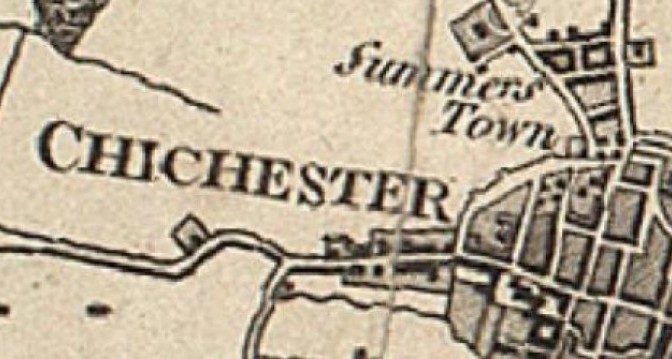This text is the fourth in a monthly series of five about the suburb of St Bartholomew’s Without in the wider context of the development of the City of Chichester. It is drawn from an edited extract of a 1935 publication (details below). As such it has kept a centuries-old way of talking about Chichester where the city walls, gates, ditch and parishes defined our boundaries, untrammelled by the modern changes that not much more than five years later would come finally to disrupt the millennial harmonies of our cityscape.
The growth of the city of Chichester is shown by its architecture. The medieval city was probably composed mainly of timber-framed buildings, and indeed, until the 17th century, when brick was employed with the exception of a few stone houses, other methods or materials were little used. At the turn of the 18th century, however, there was a gradual change in the appearance of the town, and by the end of the century it had been almost entirely rebuilt. Except for the shop-fronts and one or two alterations and replacements (due to fires) it has altered very little since then [this being 1935 remember].
Architecturally the general character of the buildings is rather primitive, but there is some excellent work in the larger houses, the most noteworthy feature being the number of beautiful 18th-century doorways and their fanlights, and the surprising number, ingenuity of arrangement, and excellent detail of the bow-fronted windows in the main streets.
Outside the West Gate the houses are mostly of the 18th century, as the older suburb of St Sepulchre (St Bartholomew), dating from the 13th century, was burnt down during the siege of December 1642. On the 1837 map below, the Westgate Brewery, established about 100 years ago [this is 1935] is to the north and Chichester Tannery is on the south side of the road.
Except for the twin eastern suburb of St Pancras, other extensions of the city outside the walls are mainly modern developments and on the north side are [1935] largely occupied by institutions. To the north of the city the land was formerly woodland. The Broyle, which was an inclosed area of woodland stocked with deer or other beasts of the chase, belonged as forest land to the king, who appointed wardens of it. This forest land was surrounded by chaces and woods belonging in the 12th and 13th centuries to lords of adjoining manors such as Savary de Bohun, Geoffrey Falconer (the wood of Depemersh), the Abbot of Sées and the Archbishop of Canterbury. These chaces and woods were divided from the King’s Broyle by ditches, which may be represented by some of the entrenchments still to be found in this district.
The Broyle passed under the grant to Adeliza, Queen of Henry I, in 1121, and William, Earl of Arundel, her second husband, put it in defence. When it came into the hands of Henry II he afforested the chaces of the neighbouring barons, from the Lavant on the east to the ditch which extends from Fishbourne to ‘Bichebroc’ on the west, and northward from the walls of the city to the lands of Savary de Bohun, apparently on the north, saving the king’s demesne wood of ‘Bichebroc,’ pertaining to the town of Chichester, and the wood of Deepmarsh, called the wood of the Falconer.
In 1227 Henry III granted to Ralph II, Bishop of Chichester, the broyles of Chichester, namely, the broyle called the King’s Broyle and the broyle called Deepmarsh, with licence to “disafforest, assart, cultivate and inclose them with ditches”. In 1243 the same bishop had a grant of free warren in his lands of Deepmarsh, ‘Affedecroft,’ ‘Castlewey’ and ‘Quenerude’ and in the woods called the King’s Broyle, ‘Hauedstock’ and ‘Sumerdal’ and in land held by the bishop of Ranulf de Brok in ‘Greningwell.’ The manor of Broyle continued to belong to the bishopric and passed under the Parliamentary sale of the Bishop’s Palace.
Sources:
Main body of text – GB Historical GIS / University of Portsmouth, Chichester St Bartholomew CP/AP through time | Census tables with data for the Parish-level Unit, A Vision of Britain through Time. URL: http://www.visionofbritain.org.uk/unit/10287480
Victoria County History Publication A History of the County of Sussex: Volume 3 Author L.F. Salzman (editor) Year published 1935 Pages 71-82. URL: http://www.british-history.ac.uk/report.aspx?compid=41659
